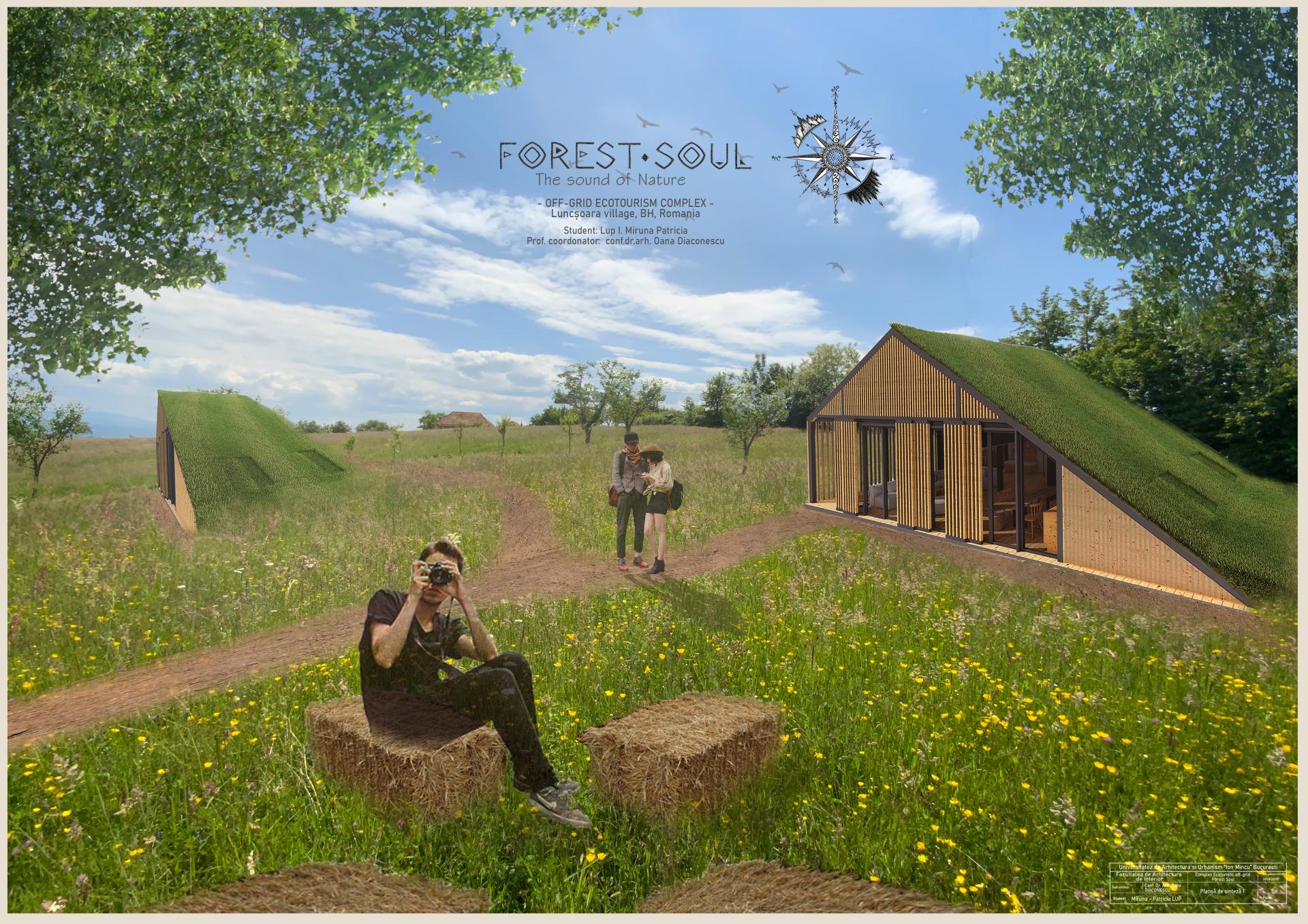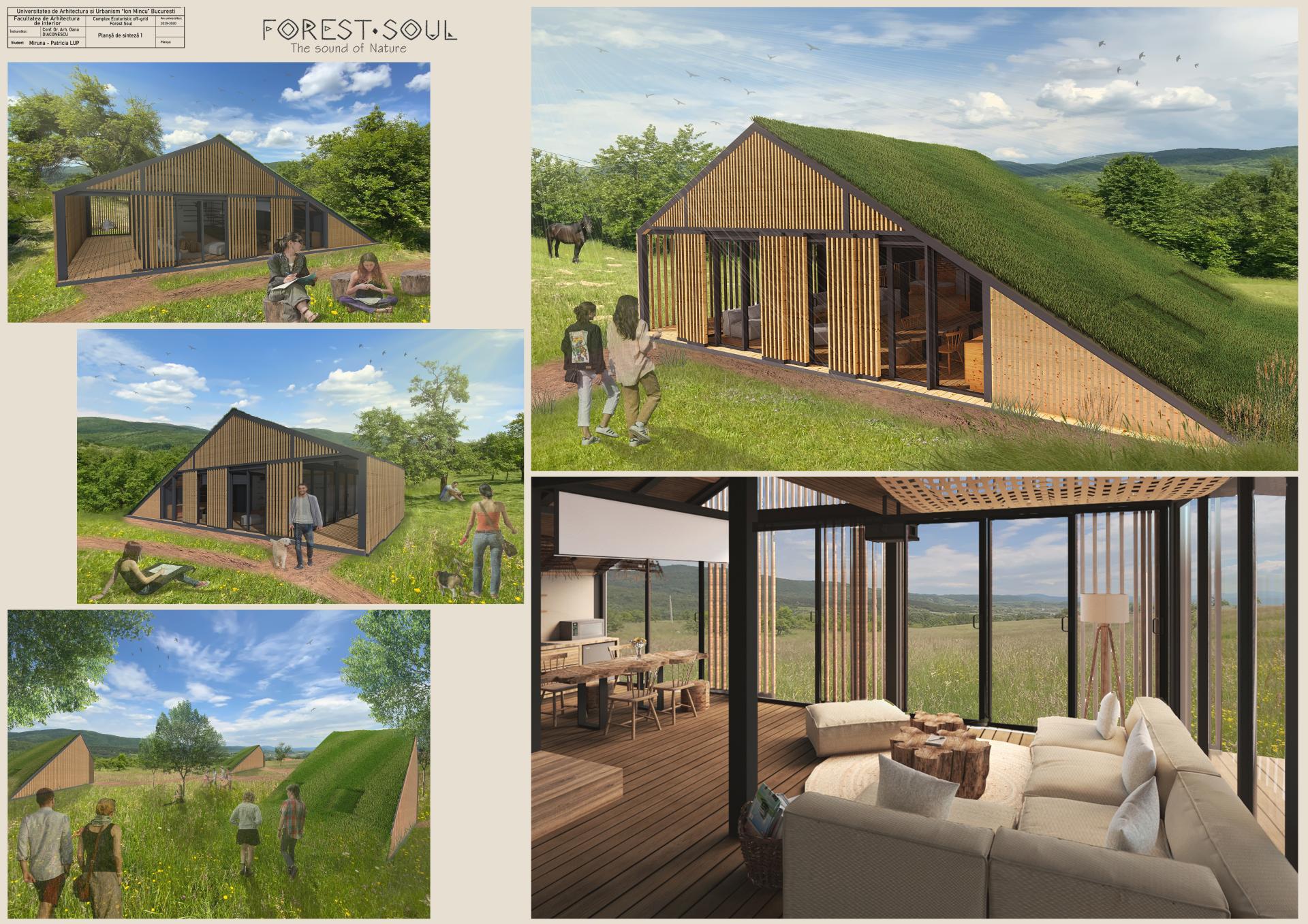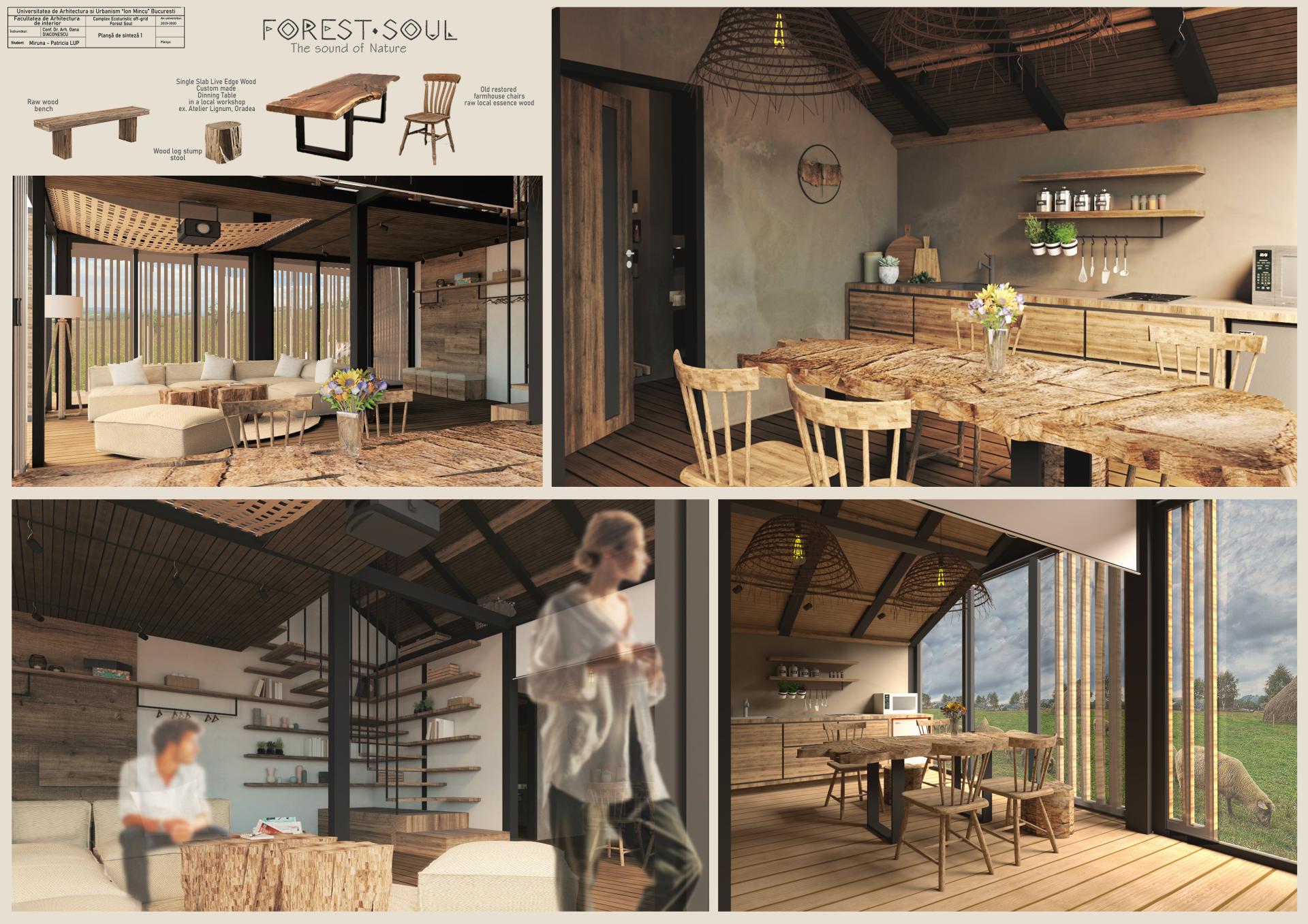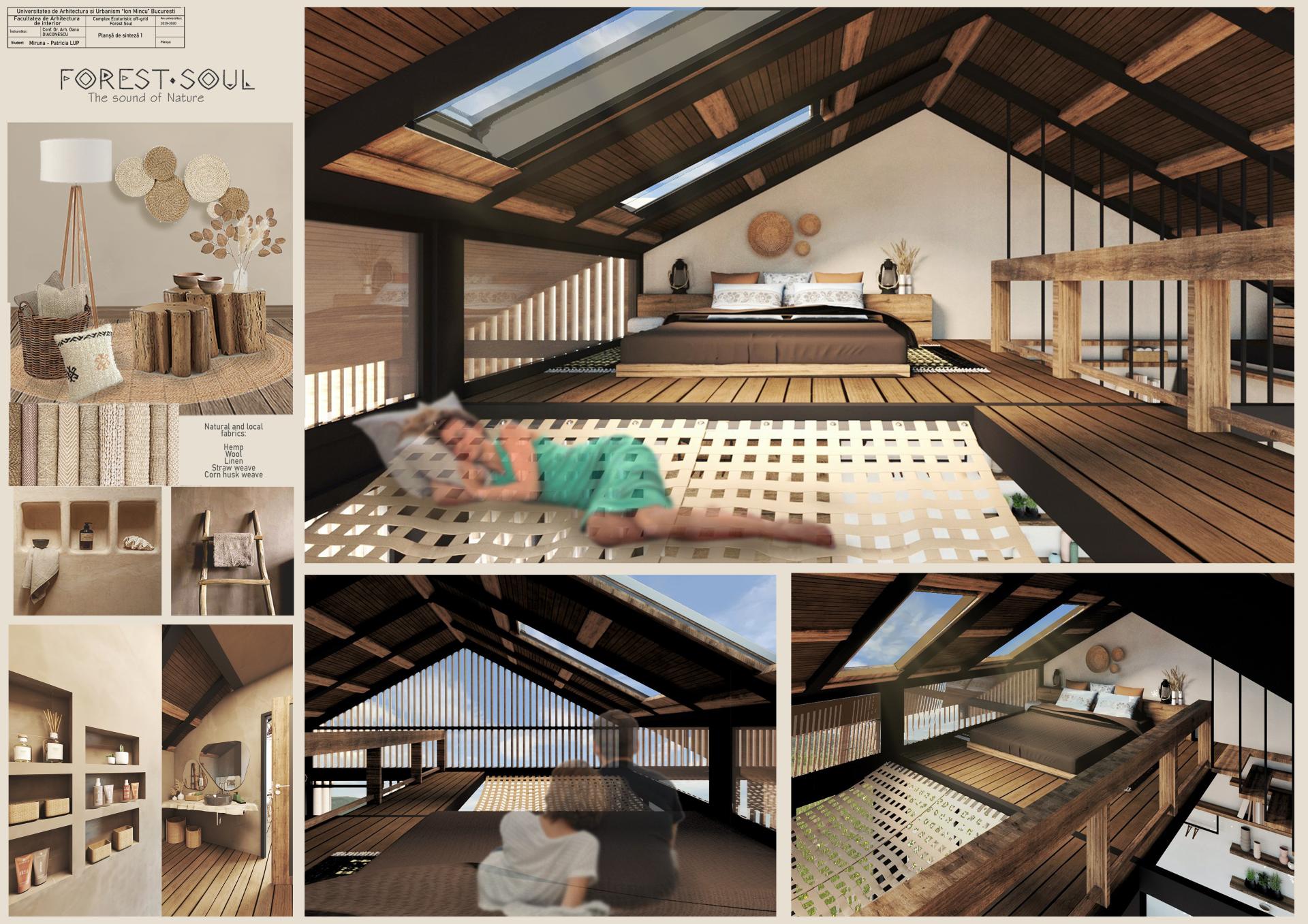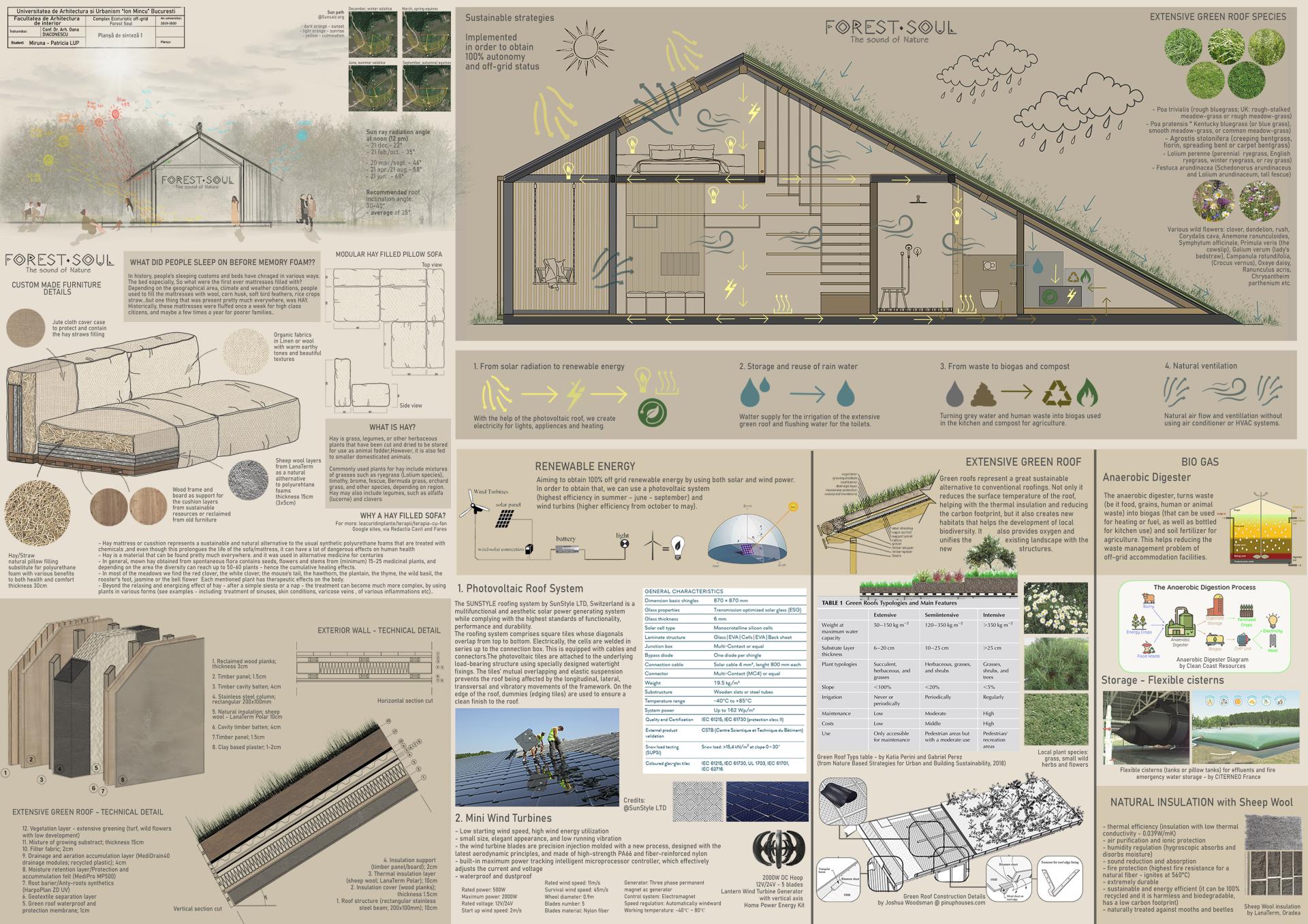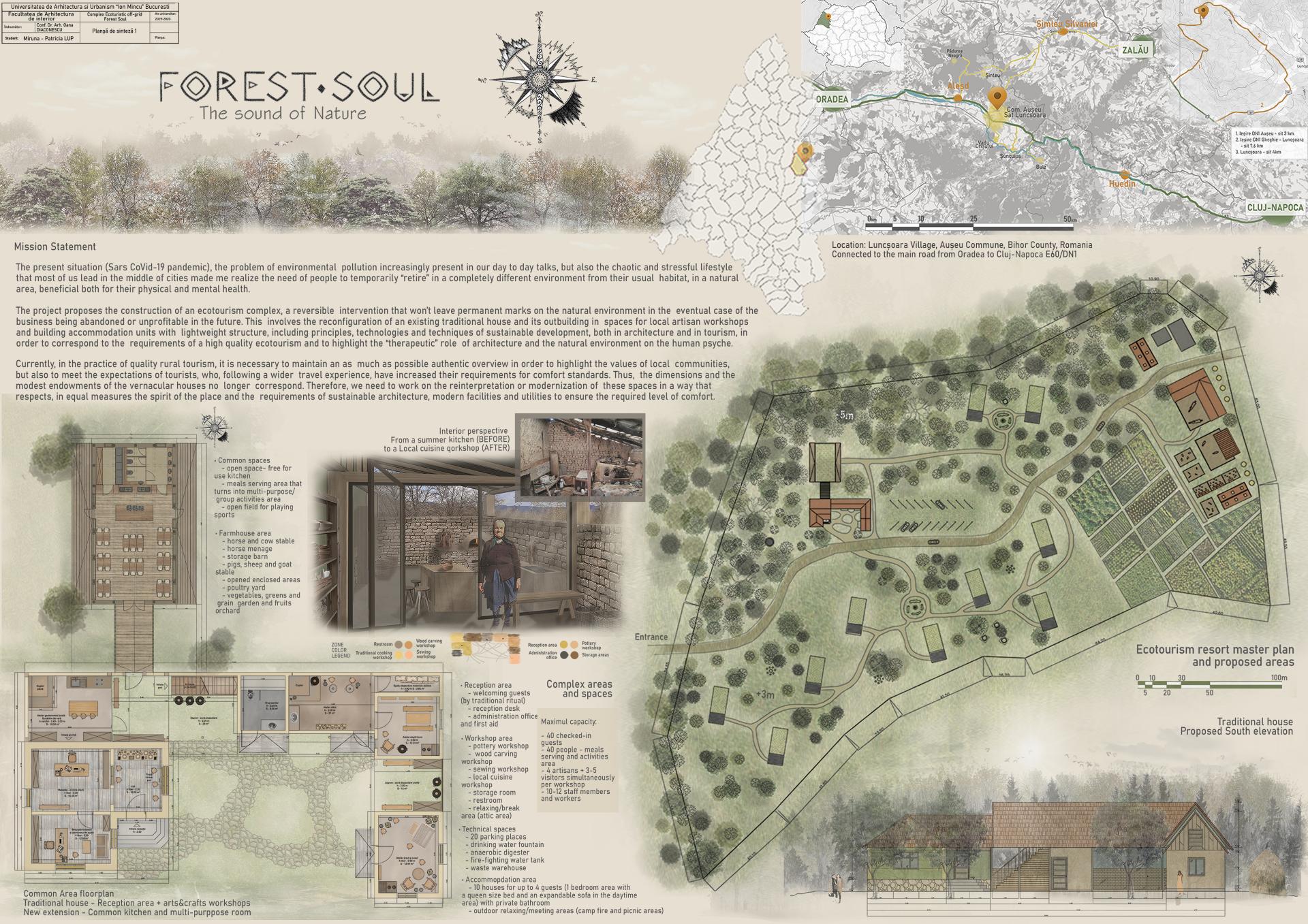Forest Soul - The sound of nature
Basic information
Project Title
Full project title
Category
Project Description
The project proposes an off-grid retreat or ecotourism complex, a reversible intervention that would not leave permanent marks on the landscape and natural environment. The concept is built around the relationship between human and nature, having the key words of sustainability, ecotourism, rural living, community, health and nature as a life and energy resource. It also aims to bond local people and communities with the tourists, promoting good quality and sustainable forms of tourism.
Geographical Scope
Project Region
Urban or rural issues
Physical or other transformations
EU Programme or fund
Which funds
Description of the project
Summary
The project proposes an off-grid retreat or ecotourism complex in a rural area in the North-Western Hills of Romania, a reversible intervention that would not leave permanent marks on the landscape and natural environment. The concept is built around the relationship between human and nature, having the key words of sustainability, ecotourism, rural living, community, health and nature as a life and energy resource. The idea is to transform and convert an old house into common spaces (artisan and traditional crafts workshops, common kitchen, reception), to build multiple modular accommodation units and create recreational spaces as well as technical spaces for the on site facilities (energy, food providing - garden and farm for Km0 products, waste management etc.).
Besides the evident benefits of holidays in nature to human health and psychic, lately, ecotourism has been seen as one of the main ways to sustainably develop communities from disadvantaged rural areas in order to save them from urban migration and eventually abandonment, turning them into “ghost villages” that become a both social and environmental problem. It also aims to bond local people and communities with the tourists, promoting good quality and sustainable forms of tourism, as well as becoming a model for future development projects in rural areas around the region.
Key objectives for sustainability
The whole idea of the complex is to be off-grid. Which means all facilities have to be solved on site by implementing and using sustainable technologies and solutions.
- ENERGY - Renewable energy, mainly from solar power due to the high light exposure of the area, especially during summer. This would be done with photovoltaic roof systems (such as the Sunstyle roof shingles from SunStyle LTD, because of the roof pitch criteria, meteorological conditions and the performance needed; or with classic photovoltaic panels)
- LANDSCAPE - The extensive green roof of the accommodation units that acts both as thermal insulation and rainfall protection, and as camouflage, helping the bungalows blend in the landscape and creating new habitats for the local biodiversity. It requires low maintenance and no extra irrigation.
- WASTE and WATER MANAGEMENT - The storage of waste and its conversion into biogas with the help of an anaerobic digester system and flexible cistern pillows. The storage of rain water for irrigation, water supply in case of fire and toilet flush water. The drinking water comes from an already existing fountain.
- INSULATION - The use of natural and local sheep wool as thermal and acoustic insulation, for a healthier environment, better performances and to offer support to the local economy by buying it from a company in the region. Also, the interior of the bungalows are covered with lime plaster, for a healthier atmosphere.
- FURNITURE - All furniture would be made from reclaimed wood in local workshops and as for textiles, only natural fiber cloth would be used (hemp, wool, linen, corn husk and straw weave)
- FARMING - km0/farm to table foods, seasonal and small scale agriculture with no chemicals used
Key objectives for aesthetics and quality
The idea of the ecotourism complex is built around the relationship between humans and nature, but also local communities and visitors. A good relationship that involves both parts is needed in order to have a successful retreat of this kind. The visitors need to feel the spirit of the place, while the locals have to be involved in the process for an authentic experience and also to gain a sense of pride, of belonging to this specific area.
The accommodation area, that is made of up to 10 bungalows and can accommodate up to 40 people, is disposed along an organic path that resembles the river’s flow through the main village, a reminder of how humans used to position their settlements back in time. In the same area there are various outdoor gathering spots such as bonfire places and picnic areas that facilitate communication. The bungalows have a modern yet vernacular and home-like look, their shape being inspired from a 10th century AD settlement from the first fortresses in the region.
In the same time, the common areas - workshops, gardens and orchards and common kitchen - are designed in such a way that people have to meet and cooperate, in the sense of co-living, working and creating together. The workshops (wood carving, traditional sewing, pottery and local gastronomy lessons) would be held by locals and encourage the guests and visitors to work and create something with their own hands, that they can later either take home as a memory totem or gift. The common kitchen through cooking together and the volunteer help of day to day tasks related to farming and orchard maintenance encourage communication and friendship making for strangers that meet here for the first time or strengthening the bonds already existing, be it family, friends or co-workers.
Key objectives for inclusion
LOCATION - The place is around 400-500m altitude above the sea level and at least 300m higher than the main road, which gives us beautiful views of the entire valley and the surrounding mountains, but it also makes it harder to access (the infrastructure is in pretty bad shape but the local authorities are working on it). But in such a place, where the presence of human intervention is minimal and barely felt, one might feel and act freely, breaking the boundaries of conventional behavior. Meaning, even an adult can feel like a kid, running up the hills, or just taking walks in the grass, or why not, take a siesta on the field admiring the clear blue skies and panoramic views. And all these make you feel free, relaxed and more in harmony with nature’s rhythm.
TARGET CLIENTS: The complex is targeted mainly for young people and team building trips, but it can also accommodate families and everyone who enjoys an alternative holiday away from the masses.
ACCESSIBILITY: The main common areas (common kitchen, workshops) are designed in a way that makes them accessible for people with disabilities. As for accommodation units, they are build on ground level and even though they have an upper level as main sleeping area, they offer sleeping beds options on the ground floor too.
OPPORTUNITIES: The complex will need local human force resources for the administration and maintenance, providing the local community with work opportunities, a thing that lacks in the area and one of the main reasons why the youngsters leave the village and choose to move in the cities nearby.
GIVING BACK TO THE COMMUNITY: The project aims to involve the local community in such a way that they feel the complex is part of it and not just a business. The schools can make field trips, organize classes in nature (learn about harvest, animals etc.) and all locals would have free access to the workshops available in the complex.
Physical or other transformations
Innovative character
The concept takes in consideration the main 3 dimensions as it follows the direction of sustainable development. The project aims to:
- Be modern and aesthetically pleasing so people would be attracted to go there for their weekend getaways or free days. Offering various activities in order to make it interesting enough to stay longer or to return after a first visit/stay.
- Be off-grid because it is in a remote area where people have managed to survive and do things in such a way for centuries and also so it would be independent and self-sufficient since I believe that is the way for a more sustainable future.
- Be a link between local communities and visitors by involving locals in the complex's workflow and administration and the tourists in the local community's life and lifestyle through traditions and customs, celebrations related to field work or holidays. Giving this way both parties a sense of belonging and authenticity.
- Help set an example of good-quality tourism, where tourists and travelers can feel the true spirit of the place in a context that offers them the comfort and facilities they need and are used to.

